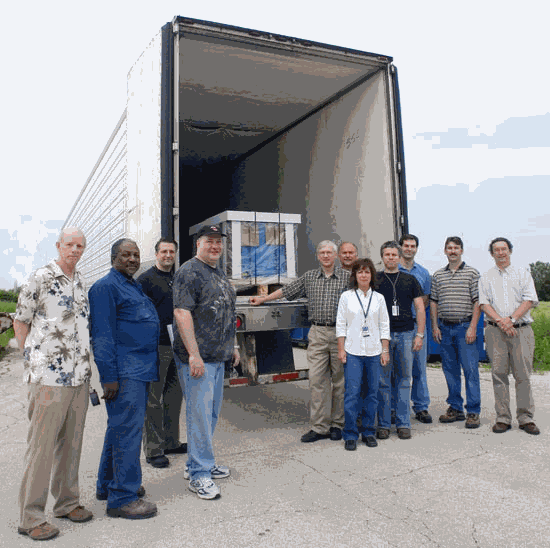Argonne expertise will once again be in the spotlight when the Linac Coherent Light Source (LCLS), the U.S. Department of Energy’s next-generation, x-ray free-electron laser light source, enables frontier materials and biological research at the Stanford Linear Accelerator Center (SLAC) beginning in 2009. Scientists, engineers, and technicians at the Argonne Advanced Photon Source (APS), together with co-workers from other parts of the Lab and private industry, have produced the string of 33 undulator insertion devices (and attendant components) that will deliver the intensely bright LCLS x-ray beams. The latest components to be shipped from Argonne to SLAC are the 33 LCLS undulator control racks. (This event followed closely behind the completion and shipment from Argonne of the final vacuum chambers for the LCLS undulators.) The final 17 racks shipped on June 19, capping a four-year design, development, and production effort by the members of the APS Engineering and Support Division (AES) Controls and Design & Drafting groups, Argonne’s Central Shops, and local vendors Advanced Circuit Design and Components Express Inc.
One of the LCLS controls racks crated, loaded, and given a send-off by the team that saw the project through: (left to right) Richard Voogd (TSD-Central Shops), Reggie Gilmore (AES-CTL), Peter Fuesz (AES-CTL), Ray Davis (AES-CTL), Eric Norum (AES-CTL), Stan Pasky (ASD-OA), Sharon Farrell (AES-CTL), Josh Stein (AES-CTL), Steve Shoaf (AES-CTL), Rich Diverio (AES-CTL), and Bob Laird (AES-CTL).
Once installed and operating in the 130-m-long LCLS undulator hall, the racks will run the Experimental Physics and Industrial Control System to monitor and control positioning, interlocking, diagnostics, and thermal status of the 33 LCLS undulators. The system provides comprehensive, real-time information on the status of each undulator, as well as allowing multiple segment operations for alignment. For example, each undulator is mounted on a girder that rests on five cam movers. The control system commands the cam movers to precisely position a undulator in five dimensions (X,Y, pitch, roll, yaw). The control design is able to position the 2-ton, 4-meter-long girder assembly to within 10 microns. For comparison, the average width of a human hair is 80 microns.
The LCLS x-ray beams will be used by researchers to image the motion of atoms, and individual molecules or small clusters of molecules; to study warm dense plasmas, new states of matter that are thought to be associated with the interiors of planets, cool dense stars, and in plasma reactions initiated from solids; and much, much more, according to the LCLS Web site.
This work was funded by the U.S. Department of Energy, Office of Science, Office of Basic Energy Sciences. Argonne National Laboratory brings the world's brightest scientists and engineers together to find exciting and creative new solutions to pressing national problems in science and technology. The nation's first national laboratory, Argonne conducts leading-edge basic and applied scientific research in virtually every scientific discipline. Argonne researchers work closely with researchers from hundreds of companies, universities, and federal, state and municipal agencies to help them solve their specific problems, advance America's scientific leadership and prepare the nation for a better future. With employees from more than 60 nations, Argonne is managed by UChicago Argonne, LLC for the U.S. Department of Energy's Office of Science.

